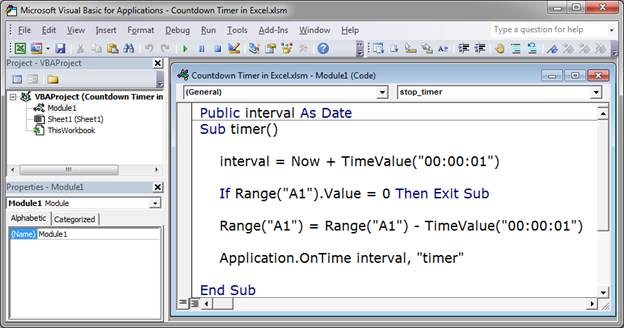

The method Application.OnTime does not exist in PowerPoint. Application.OnTime When:=TimeValue("1:30 pm"), _Ī second call to the OnTime will cancel the first call The macro name includes the project and module name. This example runs the macro named "Start" at 1:30 P.M. This example runs the macro named "Macro1" 15 seconds from the time the example is run.

Vba application ontime code#
This will run 10 seconds from the time this line of code is executed. This will run as soon as the current procedure has finished. If this argument is 0 (zero) or omitted, the macro is run regardless of how much time has elapsed since the time specified by When.

The macro will be delayed until Word has completed another task. Macros may not always run at the specified time. Tolerance - The maximum time (in seconds) that can elapse before a macro that wasn't run at the time specified by When is cancelled. For the macro to run, the document or template must be available both when the OnTime instruction is run and when the time specified by When arrives. Use the complete macro path to ensure that the correct macro is run (for example, "1"). You can also include the date (for example, "6/30 4:15 pm" or TimeValue("6/30 4:15 pm")).
Vba application ontime serial number#
Can be a string that specifies a time (for example, "4:30 pm" or "16:30"), or it can be a serial number returned by a function such as TimeValue or TimeSerial (for example, TimeValue("2:30 pm") or TimeSerial(14, 30, 00)). When - The time at which the macro is to be run. Application.OnTime Earliesttime:=dtTimeToRun, _ This tells the application to cancel the schedule. To cancel a scheduled procedure you must know the "EarliestTime" it was scheduled for.Įxactly the same syntax except you set the schedule parameter to False. It is possible to cancel a procedure that has been scheduled to run but you need to know the exact date and time it was scheduled for. Application.OnTime Earliesttime:=Now + TimeValue("00:00:10"), _ This will run 10 seconds from the time this line of code it executed. Application.OnTime Earliesttime:=Now(), _ Application.OnTime Earliesttime:="12:00pm", _ False to clear a previously set procedure. Schedule - True to schedule a new OnTime procedure. If this argument is omitted, Microsoft Excel will wait until the procedure can be run. If Microsoft Excel is not in Ready mode within 30 seconds, the procedure won't be run. For example, if LatestTime is set to EarliestTime + 30 and Microsoft Excel is not in Ready, Copy, Cut, or Find mode at EarliestTime because another procedure is running, Microsoft Excel will wait 30 seconds for the first procedure to complete. If you do not specify a 'LatestTime' then the macro will run when Excel is available after the 'EarliestTime' has passed. Latesttime - The latest time at which the procedure can be run. Procedure - The time when you want this procedure to be run. In Excel there is also an Application.WaitĮxcel Application.OnTime (Earliesttime, Procedure )ĮarliestTime - The time when you want this procedure to be run. This method will only be executed if the file containing the procedure is loaded when this line of code is executed and if the file containing the procedure is currently loaded at the time it is meant to run.Īlways use fully qualified macro names: If you start another timer before an existing timer runs, the existing timer is cancelled. Starts a background timer that runs a macro at a specified time.Įach application can only maintain one background timer set by OnTime. This can be used to run a macro at a later time or to execute a procedure at regular time intervals. You may want to refresh the data in your database every 5 minutes. There may come a time when you need to run a procedure automatically at a particular time every day.


 0 kommentar(er)
0 kommentar(er)
